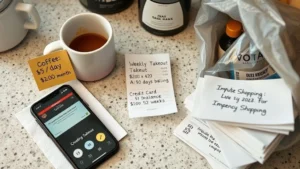Unlock Your Hidden Cash
Have You Ever Looked?
Okay, let’s get real for a second. Have you ever logged into your bank account and thought—”Where the heck did everything go?” Because… same. I used to be a champion at evaporating paychecks. All it took was a couple takeout splurges (I’m looking at you, late-night Thai delivery) and a rogue subscription or two. Suddenly, poof—another month, nearly broke, promising myself “this is the month I get serious.”
But here’s the game-changer: just pause and look at where your money actually goes. Like, for real. Grab a coffee (home brew, not from the cute $6 café) and just track what comes in and what goes out for a week. You might surprise yourself.
One time, I realized I was paying for an app I never used… for eight months. My “just $12” a month? Nearly a hundred bucks down the drain. That cash could’ve jumpstarted my emergency fund or covered half a grocery bill. (I know, ouch.)
If you want to see how to do this step by step, check out some free money management tips for adults—perfect if you’re new or just hate spreadsheets.
Reality Check Table: Savings Hiding in Plain Sight
| Spending Leak | Monthly Cost | Yearly Cost | Potential Quick Fix |
|---|---|---|---|
| Forgotten Subscriptions | $10 | $120 | Cancel or pause |
| Takeout (2x/week) | $40 | $480 | DIY meal once/week |
| Daily Coffee Shop | $80 | $960 | Home brew (not as sad as it sounds) |
Make Money Goals (That Actually Make You Feel Things)
What’s Your “Why,” Honestly?
If someone told me, “set a savings goal!”… I’d fake a smile and forget it instantly. But something changes when the goal means something real to you. Not just “retirement” (yawn), but maybe “never panic-sell my bike for rent money again.” Or “take my kid to the science museum and buy the good snacks.”
In fact, according to research on spending habits, you’re way more likely to stick with habits if they feel personal and, honestly, kind of emotional. My first big goal? A $500 emergency cushion. It felt tiny, but suddenly… rainstorm, flat tire, stress level = manageable because I had a little buffer.
Do you have something you want—like, really want—that saving could unlock? Get weirdly specific. You’ll be more motivated, promise.
Short and Long: Make It Yours
| Goal Type | Example | Timeline | Mini-Motivation |
|---|---|---|---|
| Short-Term | Emergency fund | 3-6 months | No more overdraft fees. Ever. |
| Medium | Vacation, laptop | 6–18 months | Book it, don’t dream it. |
| Long-Term | Down payment, debt-free | 3–5 years | Imagine the freedom. |
If you’re a student juggling cash flow, you’ll want to peek at these money management tips for students. (Trust me, I wish I had them back in my ramen-fueled days.)
Spending—Friend or Foe?
Are You Buying Joy or Just Buying?
Let’s talk impulse spending. My Achilles’ heel? Funky mugs and bookstore “just because” hauls. It feels great… for about fifteen minutes. Then regret sneaks in (and somehow the mug never holds actual coffee?)
What helps is a simple mindset shift: is this thing a need or just a nice-to-have? Start making it a habit to pause before you tap “Buy”—even five seconds can help. (Pro tip: if something sits in your online cart for 24 hours, you probably don’t need it… but treat yourself sometimes! Just not daily.)
You Versus the Budget: A Quick Tip Guide
- Track every cent for a week—no shame, just curiosity.
- Sort spending into two lists: Needs (rent, groceries, utilities) vs. Wants (takeout, new headphones).
- Give yourself a “fun money” limit—you won’t feel deprived, just more in control.
Following the famous 50/30/20 breakdown? It’s a classic: 50% to needs, 30% to wants, 20% to savings (or debt repayment). But rules are for tweaking—just start somewhere. Regularly checking your expenses can be eye-opening, and a friendly nudge from things like money management tips for young adults might give you inspiration to stick with it.
The Silent Hero: Compound Interest
Ah, interest. The boring math teacher of money. But, wow, is it powerful (either as your friend or your arch-nemesis). Savings in an account that pays even a little interest grows way more than you think—like, your money making tiny money babies while you sleep.
On the flip side, owing credit card debt? Compound interest makes it way harder to get out. Like fighting quicksand.
Simple experiment: Save $100 a month in something earning 5%? Check back in ten years… it’s over $15,500. (Don’t believe me? Punch it into any compound interest calculator one lazy Sunday.)
Make Saving Automatic (Because We All Forget)
Lazy Genius Moves: Automation
One of the absolute best personal money management tips I ever adopted: automatic transfers. The less I have to think about it, the more likely it gets done. Payday hits, $20 or $50 vanishes from my checking into savings before I can even miss it. Feels like tricking yourself… in a good way.
Autopay is also a savior for bills. No more “OMG, did I pay the power company this month?” panic. Plus, automating even a little extra on debt knocks years and hundreds off the totals (I cut six months off my car loan just rounding up payments—so worth it).
Automation Cheat Sheet
- Set up recurring transfers (weekly or monthly) to savings—even $5 is a start.
- Use your bank’s reminders and low-balance alerts.
- Try apps that round up purchases and stash the spare change (I call it “sneaky savings”).
Students especially: get those reminders and automations going now. For more in-depth hacks, don’t miss these practical money management tips for students.
Crush Debt (or At Least Tame It)
Are Credit Cards Hungry Monsters?
I used to see my credit card as “extra cash.” Turns out—wrong. That “free money” comes with fangs. High interest pounces so fast you barely see it coming. Best move? Pay off the highest interest debt first (called the “avalanche method”) or—if you need a quick psychological win—knock out your smallest balance (a.k.a. the “snowball method”).
There’s no shame if you’re still fighting balances. Most of us have been there… but the sooner you attack it with small, steady payments, the sooner you breathe easy. Plus, your future self will seriously thank you.
Debt Demolition: Compare Your Attack
| Method | Strength | Downside |
|---|---|---|
| Snowball | Fastest “wins,” motivational | Could pay more in total interest |
| Avalanche | Math win, less total interest paid | Slower visible progress |
Want no-cost tools to keep your momentum? Browse the free money management tips for adults—sometimes, just having a plan in front of you makes all the difference.
Grow Your Emergency Fund (Start Tiny, Dream Big)
Emergency-Ready Yet?
Life throws curveballs—trust me, nobody expects their fridge to die the week before payday. Having a little cash set aside (even a couple hundred bucks at first) shields you from stress, panic, and borrowing at gross interest rates.
But it doesn’t have to be a mountain. Don’t wait to save three months of expenses… just save something each time money hits your account. Celebrate every milestone—you’re doing it.
Mini-Emergency Fund Hack
- Start with $250—use old-school jars if the bank app feels overwhelming.
- Reward yourself (cheaply!) each time you hit a new savings goal.
- Don’t dip into it for “kinda-sorta” emergencies; only real ones.
This isn’t just for working adults—students need an emergency stash too. I learned the hard way when my car battery died two days before finals… If I’d read the money management tips for students back then, maybe I’d have skipped those frantic calls to borrow fifty bucks.
Try Earning a Little Extra (If You Can)
Is One Income Enough?
This isn’t for everyone, but if you’ve got the bandwidth, even a tiny side hustle can be a financial game-changer. Selling old textbooks, dog walking, online surveys—whatever works for your schedule. The extra stream doesn’t have to be huge to matter.
During a tight season, I found a freelance gig that brought in just $50 a week. Doesn’t sound like much, but over a year? It bailed me out of more than one “unexpected” situation. Plus, it felt kind of… empowering.
Want to brainstorm ideas that fit your stage of life? Fresh inspiration is only a click away—explore tools and stories in money management tips for young adults.
Make It Stick (And Stay Human About It)
What Helps You Keep Going?
If someone tells you “be disciplined!”…please. If I was born with iron discipline, I wouldn’t have spent $200 on birthday gifts for myself last year. The trick? Make your money moves as easy as possible for future “tired you”—automate, set up reminders, and lean on buddies for accountability.
Messing up is human—hello, I once bounced a check for $4.72 and lived to tell the tale. Learn, laugh, keep moving. And always keep growing. The internet’s full of tips, podcasts, and YouTubers who make financial learning painless. Start with one tiny change. See what happens.
Conclusion: Take the Tiniest Step—Today
Okay, you made it—and hopefully picked up an idea or two to try. If you only remember three things: Know what’s coming in and going out, set a goal that actually excites you, and automate at least one thing ASAP. That’s it. You don’t need a fancy app, just a little curiosity and a sense of humor.
And hey, if you’re feeling swamped, start with free money management tips for adults or click over to money management tips for young adults for more friendly, no-pressure guidance. Seriously—give one tiny thing a shot this week, whether it’s canceling that old subscription or socking away $5 for emergencies. Your future self (and maybe your next pizza night) will totally thank you for it.
Want to share your own “aha!” moment or money mishap? Drop it below—let’s celebrate the wins, laugh off the fails, and get financially unstuck — together.













